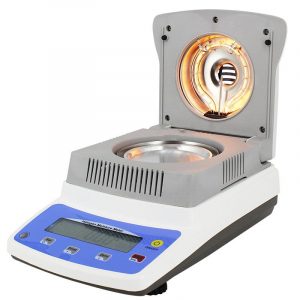Metoda oznaczania zawartości substancji stałych
Zawartość substancji stałych odnosi się do procentu lub ułamka masowego substancji stałej zawartej w cieczy. It is an indicator that describes the concentration or content of solid substances in a liquid. Solid content is often used to describe the content of solid substances in various solutions, suspensions, emulsions, colloids and other liquid systems.
The calculation formula of solid content is as follows:
Solidna treść (%) = (solid mass/total mass) × 100
Pomiędzy nimi, solid mass refers to the mass of solid matter contained in the liquid, and total mass refers to the total mass in the liquid (including the mass of solid matter and solvent or medium).
The methods for the determination of solid content vary according to the nature of the liquid and the characteristics of the solid substance. Common solid content determination methods include weighing method, metoda suszenia, filtration method, centrifugation method and so on. The specific determination method should be selected according to the liquid system and experimental requirements. The determination of solid content is of great significance for the production and quality control of liquid systems. In various industrial fields, such as chemical, żywność, farmaceutyczny, włókienniczy, itp., the determination of solid content is often used to monitor and adjust the composition and nature of products to ensure product quality and production effect.
Metoda oznaczania zawartości substancji stałych
Drying method: the liquid sample to be measured is placed in a pre-weighed container, and the solvent in the liquid is evaporated or volatilized by heating or vacuum drying, leaving solid substances. The mass of the solid material was then weighed and the solid content calculated.
Centrifugation: The separation of suspended particles or precipitates from a liquid by centrifugation, followed by drying and weighing of the separated solid material. Based on the mass of the solid material and the total mass of the liquid sample, the solid content is calculated.
Metoda filtracji: Liquid samples are filtered using filter paper or microporous membranes to trap solid particles or precipitates on the filter medium. The filter medium was then dried together with the solid material and weighed. The solid content was calculated by comparing the mass of the solid material with the total mass of the liquid sample.
Determination method after dissolution: badana próbka cieczy jest całkowicie rozpuszczona, and the concentration or content of solid substances in the solution is determined by appropriate analytical methods (takich jak spektroskopia, kolorymetria, środek ciężkości, itp.). Then, based on the concentration of solid material and the total volume or mass of the liquid sample, the solid content is calculated.

Metoda oznaczania zawartości substancji stałych
Podstawowe kroki operacji:
Drying method:
A. Przygotuj się do zważenia pojemnika i zapisz masę pojemnika.
B. Transfer the liquid sample to be tested to the container.
C. Using heating equipment or vacuum desiccator, the solvent in the liquid sample is evaporated or volatilized, leaving the solid material.
D. Place the container in a desiccator together with the solid material to dry completely. mi. Weigh the mass of the dried container and solid material and record the mass value.
F. Calculate the solid content based on the mass of the solid material and the total mass of the liquid sample.
Centrifugation method:
A. Przygotuj probówkę wirówkową lub wirówkę i zapisz jej masę.
B. Pour the liquid sample to be tested into the centrifuge tube.
C. Centrifugal the liquid sample using a centrifuge to separate solid particles or precipitates.
D. Transfer the solid material obtained by centrifugation to a dry container.
mi. Place the container in a desiccator together with the solid material to dry completely.
F. Weigh the mass of the dried container and solid material and record the mass value. G. Calculate the solid content based on the mass of the solid material and the total mass of the liquid sample.
Metoda filtracji:
A. Przygotuj urządzenie filtrujące, including filter paper or microporous membrane, Filtr lejek, itp.
B. Pour the liquid sample to be tested into a filter funnel and filter the liquid through filter paper or microporous membrane.
C. Leave solid particles or precipitates on filter paper or microporous membrane.
D. Transfer filter paper or microporous membrane and solid material to a drying container.
mi. Place the container in a desiccator together with the solid material to dry completely. F. Weigh the mass of the dried container and solid material and record the mass value.
G. Calculate the solid content based on the mass of the solid material and the total mass of the liquid sample.
Metoda oznaczania zawartości substancji stałych
Determination after dissolution:
A. Prepare the appropriate solvent and completely dissolve the liquid sample to be tested.
B. Select appropriate analytical methods according to the determination requirements, takich jak spektroskopia, kolorymetria, środek ciężkości, itp., do określenia stężenia lub zawartości substancji stałych w roztworze.
C. Record the results of the determination, łącznie ze stężeniem substancji stałej i całkowitą objętością lub masą próbki ciekłej.
D. Oblicz zawartość substancji stałych na podstawie stężenia i całkowitej objętości lub masy.
Powyższe to podstawowe kroki operacji, the specific operation should be based on the experimental requirements and methods to select appropriate instruments and reagents, and in accordance with the relevant operating procedures and standards. Metodę oznaczania zawartości substancji stałych należy wybrać w zależności od konkretnych właściwości próbki i wymagań pomiarowych. Different methods are suitable for different types of solid substances and liquid samples. In the determination of solid content, należy przestrzegać odpowiednich procedur operacyjnych i standardów, aby zapewnić dokładność i powtarzalność wyników pomiarów.
